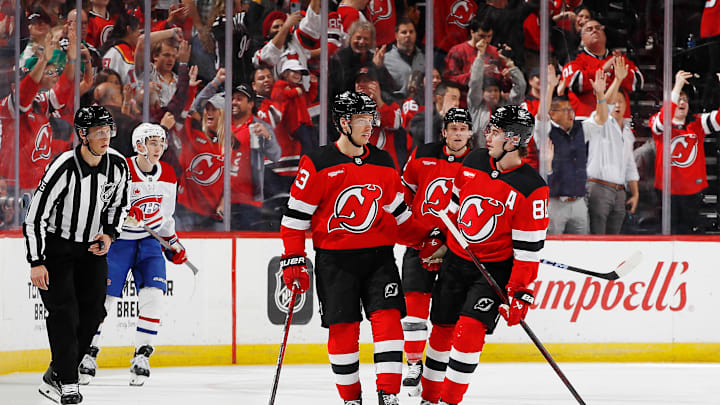The New Jersey Devils' power play in 2023-24 started hot. Very hot. You could even have viewed the team as power-play merchants, as their power-play was clicking at 36 percent through the end of November. But as we saw as the season progressed, that was a mirage.
Injuries were a factor. Not having Dougie Hamilton, who appeared in just 20 games last season, played a part in the Devils' power-play struggles. As did Jack Hughes, who played with one healthy shoulder from the All-Star Break onward.
The good news is everyone is healthy now, and the Devils' power play is clicking. But it's not just having everyone fully healthy that's making a difference. The Devils hired Jeremy Colliton as an assistant this offseason to oversee the power play, and he seems to have made some significant stylistic tweaks that's helped the power play look lethal.
Devils Power Play Has a Much Different Look
By the numbers, the Devils' power play looks much different. Power-play sample sizes are still pretty small since we're only 21 games into the season, but they're generating plenty of quality looks on the man advantage.
The Devils are averaging 9.32 expected goals per 60 minutes on the power play, the sixth-best rate in the NHL. They're also averaging 30.99 high-danger chances per 60, the fifth-ranked rate. Whichever way you look at it, they're getting good looks.
For context's sake, the Devils averaged 7.96 expected goals and 25.11 high-danger chances per 60 minutes on the power play last season. Those rates ranked 18th and 14th in the NHL, respectively. Not great, not terrible, but certainly not close to where Colliton has the Devils to start this season.
So what's changed?
We mentioned health. Having Hamilton quarterbacking the first power-play unit makes a big difference, and Jack Hughes is starting to pick corners on the power-play. But some new personnel have helped, too.
Stefan Noesen played second-unit minutes with the Carolina Hurricanes, but he was a solid net-front presence. There were more than a few instances in his two years with the Hurricanes where he cleaned up rebounds or redirected pucks in high-danger areas for power-play goals.
He's been doing with the Devils this season, but on the first unit. Take the 6-2 win against the Florida Panthers last week, for example. Sure, the puck went off Aaron Ekblad's stick, but Noesen one-timed the puck from a high-danger area after some quick one-touch passing from the Devils.
That quick one-touch passing isn't something we saw enough of from the Devils last season, too. Most times, their puck and player movement was too stagnant, making it well too easy for opponents' penalty kills to shut down the Devils' power play.
But this season, at least to start, the Devils' puck and player movement has been much more crisp and fluid. Jack Han talked about it on a recent episode of The Hockey PDOcast and how the Devils are running a motion-based power play that will make it difficult for penalty kills to defend.
Han and Dimitri Filipovic noted that the Devils' power play looks similar to the Edmonton Oilers, who essentially allow Connor McDavid to freelance in the offensive zone. The Devils are doing the same thing with Jack Hughes and, to a lesser extent, Jesper Bratt, which allows the power play to be more creative.
You can see that with plenty of the Devils' power plays when watching the games on TV or if you're at the Prudential Center. Nobody is standing in one position. Players are constantly moving around, and that's because Hughes has the freedom to roam around and pull penalty killers out of place.
So far, that's working for the Devils, and we see it in the shot rates we mentioned above. They're generating quality looks, which have actually improved since the season started.
The Devils averaged 8.41 expected goals and 28.68 high-danger chances per 60 through their first ten games. That's quite good, but they've found another level to their power play. And there might even be room for it to get better, too.
Han and Filipovic also noted that with motion-based power plays like the Devils', it might take a bit of time for players to get used to the whole motion thing. That's why the Devils' power play didn't look too hot for maybe the first ten games of this season. But since then, it's been firing on all cylinders, and that's a sign players are getting more comfortable with the motion-based tendencies.
That's why the Devils' power play looks like it's in a good position to sustain its early-season success. McDavid is a unicorn, which makes comparing any power play to the Oilers' a bit unfair, but there are reasons the comparison makes sense.
Still, the Oilers have had plenty of success with a motion-based power play over the last few seasons. And the Devils have the right personnel to run it with Hughes, Hamilton, Noesen, Bratt and Nico Hischier. You'd like a bit more from the second unit, but if the first wave continues to do what it's doing, the Devils' power play should remain one of the best in the NHL all season.
Advanced stats from Natural Stat Trick
